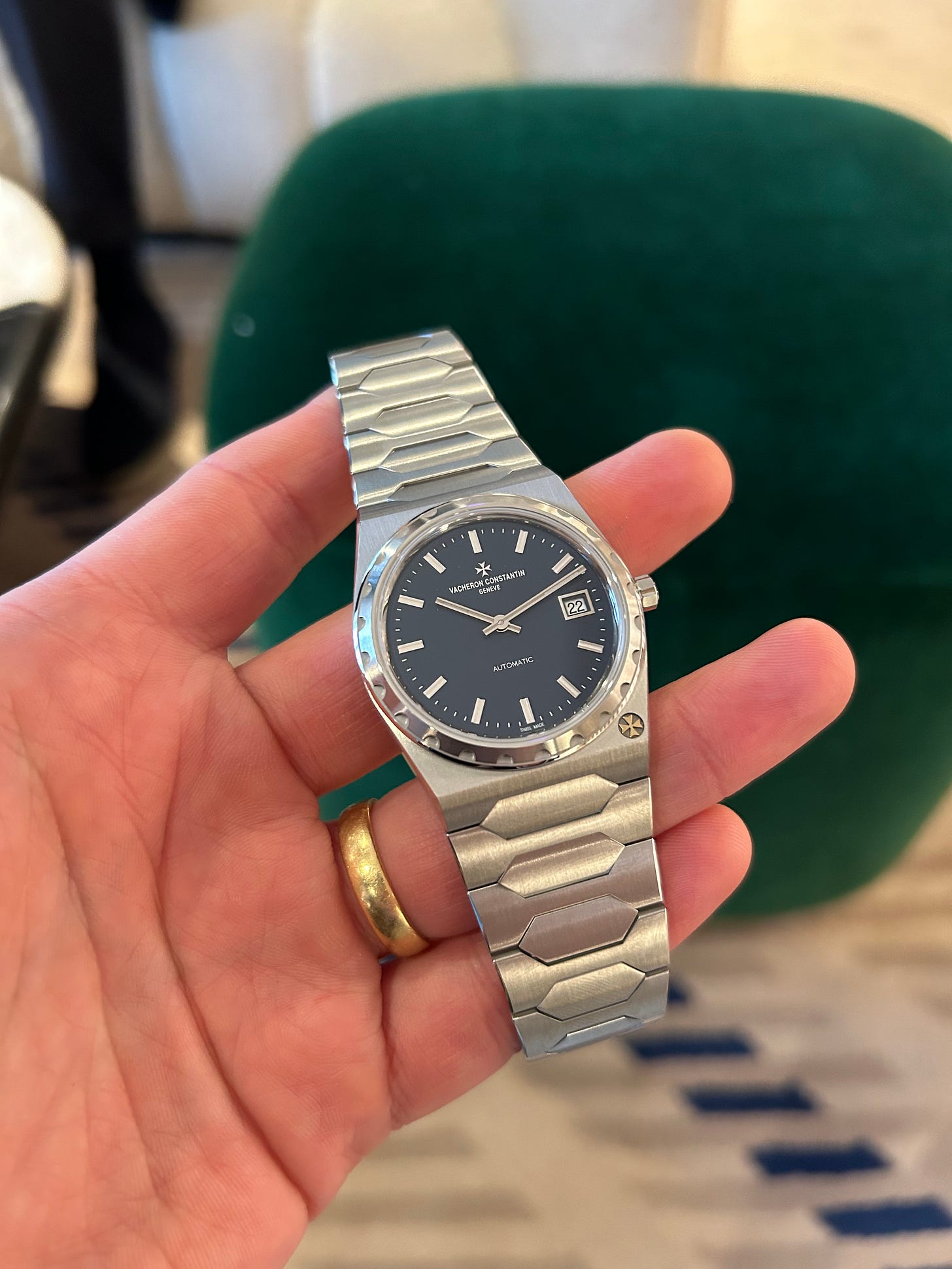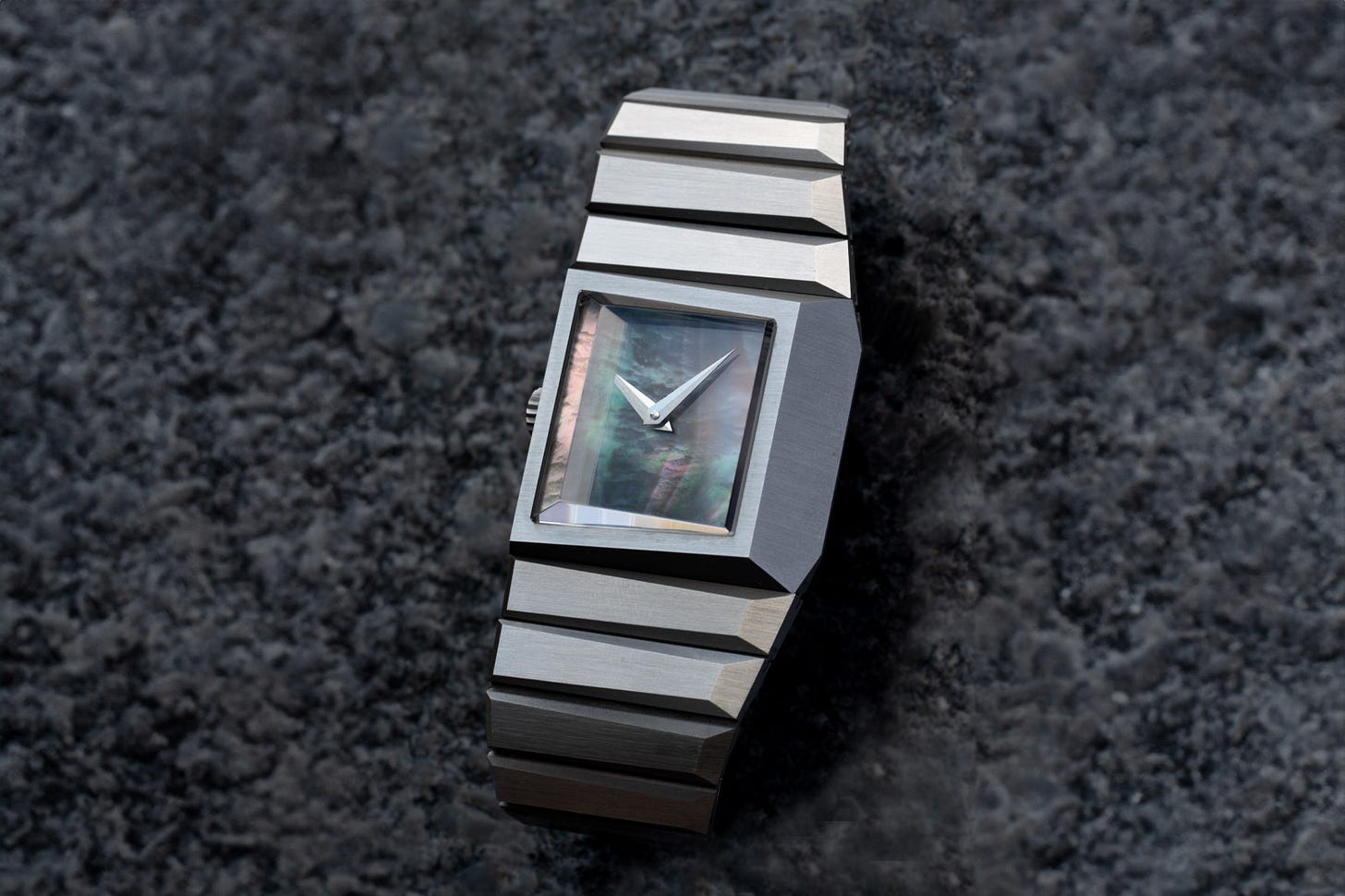Issue 138: Toledano & Chan interview; Back to the 222; The watchmakers with nothing to do
How does a runaway hit brand keep the momentum up?
Hello and welcome back to The Fourth Wheel, the weekly watch newsletter that sat down the other day and realised it’s not far off 150 issues. Where did that go? My century-and-a-half will land just after Watches and Wonders. As you read this, I am frantically arranging meetings, catch-ups and illicit rendezvous for that glorious, stressful week - if you’re going to be in Geneva that week, give me a heads-up and I’ll see if we can find a minute to share an espresso. Truly, I can’t wait: as you’ll read below, the industry is in a fractious state, and while I take no joy in it, there is so much to pry into before you even think about the hundreds of actual watches to discover. I may be biased, but I feel like now more than ever, this is a time for finding out just what the hell is really going on.
Today, you’ll read a tiny taste of that, but the main event is an interview with the two gentlemen behind Toledano & Chan, one of the stories of 2024. We sat outside on a January afternoon in Mayfair and discussed the origins, present and future of everyone’s favourite Brutalist watch brand. It’s a good one. Enjoy.
The Fourth Wheel is a reader-supported publication with no advertising, sponsorship or commercial partnerships to influence its content. It is made possible by the generous support of its readers: if you think watch journalism could do with a voice that exists outside of the usual media dynamic, please consider taking out a paid subscription. You can start with a free trial!
Here’s a little taste of what you might have missed recently:
Some more thoughts on the Vacheron Constantin 222
Up close and impersonal
My observations on the steel 222 last week were necessarily brief; I hadn’t seen the watch in person. Now I have.
I was almost speechless when they handed me the watch - but not out of dumbstruck reverence. It was just… exactly as expected. It’s a funny thing to say about one of the most in-demand and for the moment at least, unavailable watches on the market but if you have seen photographs and read reviews, you know this watch. Some watches reveal themselves in person to be completely other than imagined; either they come to life as the light plays on them, as a Rolex Day-Date does, or their absence of weight is startling, or the hand-craft, where applicable, is better or more interesting up close. (Some watches reveal themselves to be a lot worse in person, but that’s a topic for another issue). The steel 222 was not such a watch, for me. Its thinness is hard to gauge from still images, I suppose, and it is a fairly thin watch at 7.95mm (or 8mm if, like me, you find 0.05mm difficult to perceive and irrelevant to note). But otherwise it was a straightforward encounter.
I was unable to properly react to the clasp, which some on Instagram had mentioned as a weak point, as the watch I held had a full length bracelet, dangling an inch or so wide of my wrist. The bracelet is perhaps most notable for its relative simplicity - certainly simplicity of texture, lacking the intricate contrasts that have become popular on the Overseas and elsewhere as everyone looks to show off their brushing and polishing. So it’s got a more retro character as a result - and to my eye, something of a reptilian one as well. The proportions are probably the other most unusual thing about the 222, with a “lug width”, or end-link width, that’s much closer to the full case diameter than a modern-day integrated bracelet watch. But now I’m getting close to simply reviewing the 222 as a design, and to return to my original point, we already know.
Executing it in steel was inevitable - as are the versions that will follow, I’m sure: my money would be on white gold in two years’ time and a ‘collection excellence platine’, i.e. a platinum version after that. One of these two, I expect, will have the grey dial several fans have said they’d prefer. Hopefully VC will be brave and try a bi-metal number as well, as it would be faithful to the original range. The blue dial was fairly predictable as well; I have to say, it works perfectly nicely and its matte finish suits the watch well but I didn’t run helter-skelter down the street to the nearest phone box in order to tell the world about it either.
Perhaps I sound underwhelmed. I don’t think I am: I think I am whelmed. I think this watch leaves me unchanged - a neutral experience. Expectations, and context, are key. The 222 of 2022 had been hotly anticipated, and Vacheron delivered a pitch-perfect revival design. It happened at Watches and Wonders, and it stole the show. Coming in gold, it also seemed to catch the right trend at the right time: more of a 1980s-esque statement of excess that chimed with the bubbly, excitable nature of the market in 2022. It felt in line with the resurgence of the Santos and the Polo, rather than catching the tail end of the boom in 1970s steel sports watches. This launch comes in January, and while steel is hardly unpopular (the waiting list for one will be prolonged, regardless of whatever pundits like me might say) it is not experiencing a mania like it did a few years ago. Perhaps more to the point nothing is experiencing a mania like that of 2-3 years ago. Which leads neatly into…
Just how bad is it out there?
Away from the champagne launches and Instagram posts, the downturn is at risk of turning into a crisis
In the latest issue of Unpolished, Tony Traina referred to recent Swiss news reports that said Jaeger-LeCoultre - the Grand Maison itself! - has had to take advantage of the government support scheme to furlough its workers. Known in French as réduction des horaires de travail (RHT), this is the same scheme that readers will remember Girard-Perregaux and Ulysse Nardin making use of since about this time last year.
Things are even worse than Tony reported. Some are talking of a decline that hasn’t been seen in a generation or more.
According to local news stories, hundreds of Jaeger-LeCoultre’s 1000-or-so employees are now only working Monday-Wednesday. This has been the case since before Christmas and is set to continue until at least the end of February, when the scheme may be reviewed. Le Temps reports that Jaeger-LeCoultre and Breguet are the brands on high alert, but the situation is said to be more widespread. Some supplier workshops are reportedly closed completely, albeit temporarily for now.
I had a phone call this week from a senior figure at an independent brand who had just returned from meetings in the Vallee de Joux with some of his suppliers. He told me that the mood was “really bad”. Big brands are apparently cutting their orders across the board, and it’s not limited to Richemont or Swatch Group. “Normally, the traffic on the roads is really bad at the end of the day,” he said. “But right now, there’s nothing. Nobody’s at work.” He told me that at one brand, staff were just sitting around with nothing to do.
For smaller brands like his, the silver lining is that for once, they can get parts faster as suppliers aren’t overloaded with work from mainstream manufacturers. But it’s a pyrrhic victory of sorts: the independent brands need the big ones healthy in order to keep the suppliers above water in the first place.
“It’s worse than 2007,” he told me. “Worse than 20151. Much worse.”
A lot hinges on orders placed at Watches and Wonders - even more than usual - but given the time taken to get watches to market, this downturn is still going to have to work its way through the system like a wave, and there is no certainty that we’ve seen the worst of it yet.
Do you work at, or with, a major watch brand? Tell me what’s really going on: all tips and information will be received with guaranteed anonymity.
Watches of Switzerland UK profit falls 64 per cent
Despite steady global performance for its parent company, WoS had a harder year at home
Watches of Switzerland Company Ltd, the UK subsidiary of Watches of Switzerland Group, just reported a year-on-year fall in revenue and operating profit in its recent accounts, which cover the period up to April 2024. Revenue fell from £882,198,000 to £832,766,000, a drop of 5.6 per cent, and profit fell 63.7 per cent from £87,046,000 to £31,522,000.
The directors note claims that the company grew market share in what it describes as a challenging year for the market overall. WoS UK operates 158 stores including Mappin & Webb and Goldsmiths, an number that increased by 18 during the year in question.
Operating profit was hit by just under £18m worth of ‘onerous leases’ and ‘impaired showroom assets’; in layman’s terms, those refer to contracts that would cost more to fulfil than the company stands to make from them, and assets whose market value has seen them depreciate below what the company paid for them. In this case, WoS is saying some of its real estate is costing it money, essentially, and that it expects this to be a one-off situation. The company also spent £733,000 on acquiring a number of showrooms from high street jeweller Ernest Jones, and just over £2m on the ongoing fit-out of the 7,200 square foot flagship Rolex store which it will operate on Old Bond St. The £2m figure is said to include rent for the site as well as the refurbishment costs for the year. With these and other smaller exceptional costs taken out, WoS UK’s operating profit - i.e. a better reflection of how much money it’s actually making selling watches - would be a healthier £52,526,000, although that would still represent a 40 per cent drop year-on-year.
It isn’t that surprising: we knew it was a tough year. It’s useful to see how the country’s largest watch retailer is weathering this market, though. Now, let’s get on with the main course.
Toledano & Chan looks to the future
In which your correspondent turns a reckless comment into a productive conversation
Before Christmas, I took part in a round-table discussion for Esquire UK with George Bamford, Scarlett Baker and Esquire’s Johnny Davis. We discussed a whole year’s worth of watch launches, trends, mis-steps, sales, cultural phenomena and accidentally coined the word ‘humbition’. (Well, George did).
In the middle of this lengthy chat, I brought up something I’d recently discussed with the founder of an independent brand of about a decade’s standing2; the idea that, as he put it, “it’s easy to sell your first watch.” Meaning, a lot of brands burst onto the scene with something that garners plenty of attention and possibly sells out, but the company later finds the follow-up harder.
My mistake was having the temerity to attach this thought to my musings on three ‘it’ brands of 2024: Berneron, Toledano & Chan, and Anoma. The first, I said, clearly had a long-term plan, but I wasn’t so sure about the other two. Not unreasonably, Phil Toledano got in touch to point out that I hadn’t actually asked him what his long-term plan was, and that he did in fact have one, if I cared to know about it. Graciously, he took the whole thing in good spirits and offered to spend time remedying the gaps in my knowledge.
Humble pie consumed, I took the opportunity to sit down with both Phil and Alfred Chan, his business partner on a recent visit to London (and only their second time meeting in real life, if you can believe it) and set the record straight. And yes, I will hopefully soon do the same thing with Anoma as well, in a future issue.
TFW: So, here we are - and we’ve got your launch model, the B/1 with the lapis lazuli dial, and the B/1.2. Tell me about the journey from this one to the later model.
Phil Toledano: When we made the original, it was perfect and complete, but then when you see it with the crystal, you realise that you’ve started a language and there are so many more words to add to this language.
TFW: Did you come up with the B/1.2 before the B/1 even launched?
PT: No, not at all. This came afterwards. It has been a continual six to eight month explosion of ideas. Now we have the next few years planned out.
TFW: That brings us neatly to our reason for being here: the fact that I was a bit rude about your future potential. Which I didn’t really mean to be. But if I am honest, I stand by the basic point that a lot of people decided to launch watch brands when it felt like times were great and have come into a market that's not as great as maybe when they decided to do it. And I think objectively, and I don't mean you particularly, but at some point we will look back and go, ‘well, not everyone made it’.
PT: It's a fair question. When we started this conversation in 2020, the landscape was not what it is now. It was all Rolex subs still. The idea of doing a watch like this in 2020 was lunacy, but we did it because we were just so enamoured. We just wanted to make something that we loved, and if other people liked it that was a bonus. We certainly did not expect the fervour and the frenzy that occurred.
TFW: The B/1 launched into a world where not only was it rapturously received, but it was quite quickly positioned at the centre of a number of emerging trends. Did it surprise you that an idea that you'd had four years previously suddenly seemed to be bang on the money?
PT: Well, this is the American side of me talking, having lived in New York for 20 years. Something that my wife says is one of my only qualities is that I tend to see things a little bit before they happen. But it wasn't like we sat down and said, ‘okay, what's going to be hot in four years?’ It is exciting and exhilarating and also terrifying because the problem of being at the centre of things is you have to continue that success. You don't want to be a thing that is just hot for six months or a year or two years. We have a pretty good plan for the next four years. The most important thing is longevity.
Keep reading with a 7-day free trial
Subscribe to The Fourth Wheel to keep reading this post and get 7 days of free access to the full post archives.










